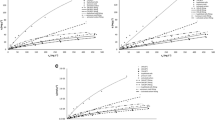Summary
The phenol degradation by Candida sp. and Pseudomonas sp. immobilized on activated carbon was investigated. Thanks to its great adsorptive surface, activated carbon is suited as supporting material for microorganisms and also provides a high adsorption capacity for phenol.
The immobilization by adsorption avoids any unphysiological treatment of the microorganisms. One gram activated carbon adsorbed in 10 h about 4×109 Pseudomonas cells and 3×108 Candida cells. While the free cells did not tolerate more than 1.5 g/l phenol, the adsorbed microorganisms survived at temporary high phenol concentrations up to 15 g/l, and they degraded about 90% of the adsorbed phenol.
The activated carbon operated like a “depot”: the adsorbed phenol diffused out of the carbon and could be metabolized by the microorganisms. The results give an explanation of the stimulating effect of activated carbon in the treatment of waste waters observed until now.
Similar content being viewed by others
References
Andrews GF, Tien C (1981) Bacterial film growth in adsorbent surfaces. AIChEJ 27:396–403
Bettmann H, Rehm HJ (1984) Degradation of phenol by polymer entrapped microorganisms. Appl Microbiol Biotechnol 20:285–290
Dagley S (1971) Catabolism of aromatic compounds by microorganisms. Adv Microb Physiol 6:1–46
Gaal A, Neujahr HY (1979) Metabolism of phenol and resorcinol in Trichosporon cutaneum. J Bacteriol 137:13–21
Jüntgen H, Jockers R, Klein J (1981) Adsorptive Aufbereitung von Prozess- und Abwässern mit Aktivkohle. VDI-Forschungsheft No. 607
Kienle H von, Bäder E (1980) Aktivkohle und ihre industrielle Anwendung. Ferdinand Enke Verlag, Stuttgart
Klein J, Jüntgen H (1977) Adsorption zur Reinigung hochbelasteter Abwässer. Umwelt 6:465–470
Klein J, Hackel U, Wagner F (1979) Phenol degradation by Candida tropicalis whole cells entrapped in polymeric ionic networks. In: Venkatasubramanian K (ed) Immobilized microbial cells. ACS Symp Ser 106:101–118
Martin RW (1949) Rapid colorimetric estimation of phenol. Anal Chem 21:1419
Pfennig N, Lippert KD (1966), Über das Vitamin B12-Bedürfnis phototropher Schwefelbakterien. Arch Mikrobiol 55:245–256
Shimp RJ, Pfaender FK (1982) Effects of surface area and flow rate on marinal bacterial growth in activated carbon columns. Appl Environ Microbiol 44:471–477
Author information
Authors and Affiliations
Rights and permissions
About this article
Cite this article
Ehrhardt, H.M., Rehm, H.J. Phenol degradation by microorganisms adsorbed on activated carbon. Appl Microbiol Biotechnol 21, 32–36 (1985). https://doi.org/10.1007/BF00252358
Received:
Issue Date:
DOI: https://doi.org/10.1007/BF00252358




